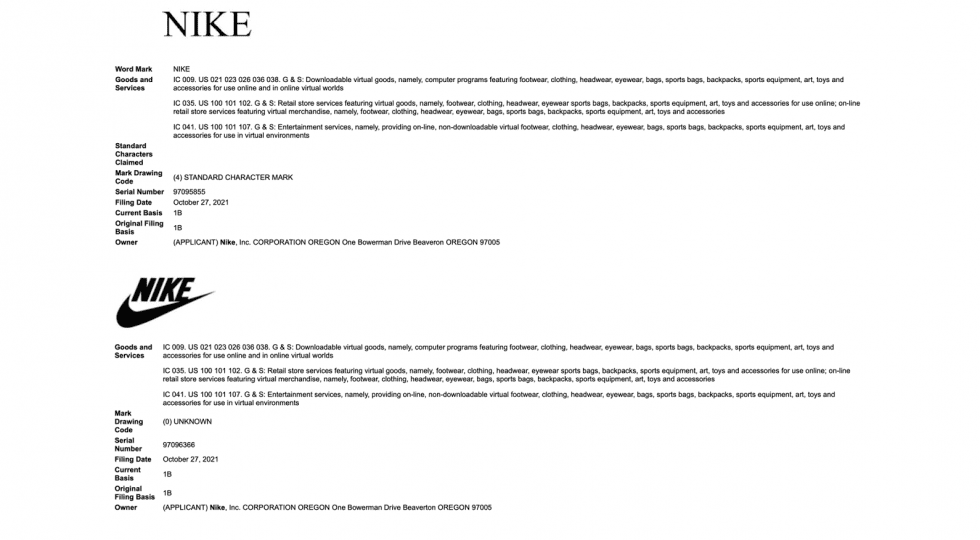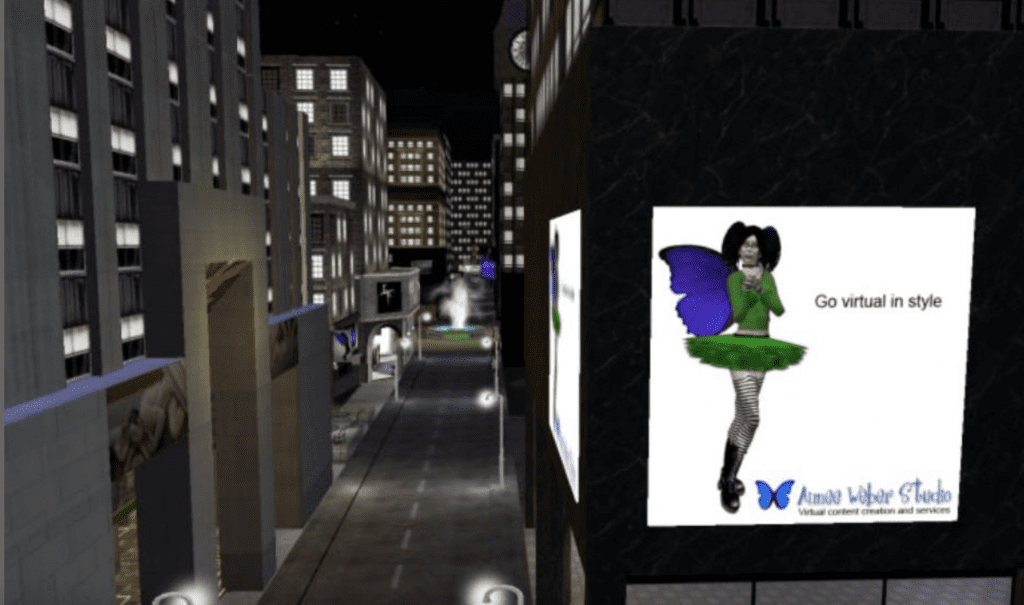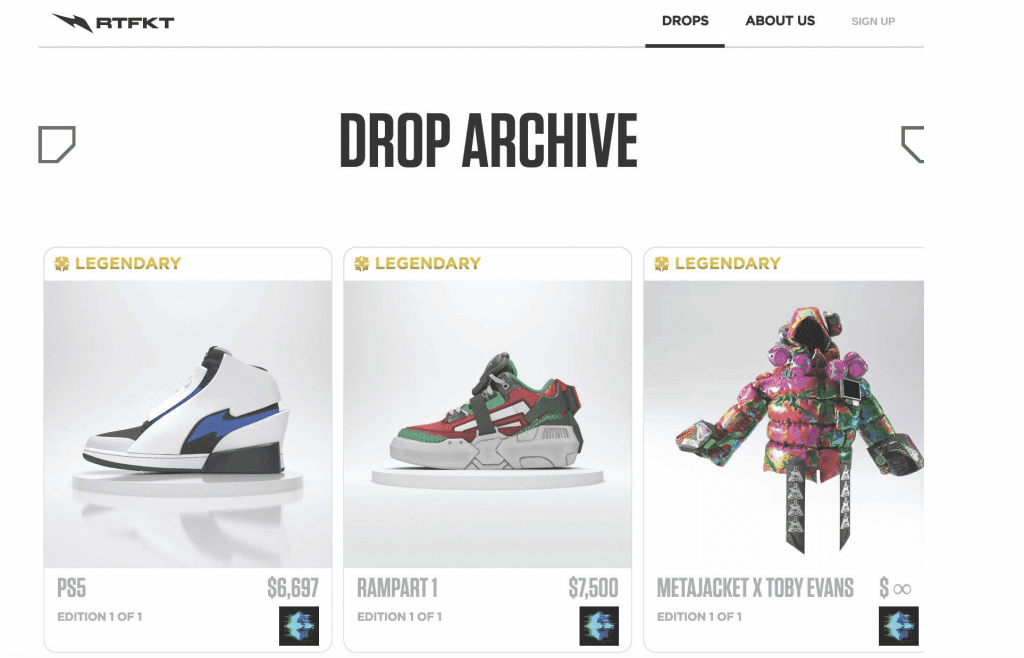Deep Dives
Nike is proving to be a leader when it comes to trademark filings related to metaverse, having filed a handful of trademark applications last fall for its famous word mark and Swoosh logo, among source-indicating assets, for use on “downloadable virtual goods;” “retail store services featuring virtual goods;” and “entertainment services, namely, providing on-line, non-downloadable virtual footwear, clothing, headwear, eyewear, [and] bags,” among other things, “for use in virtual environments.”
As I noted recently, part of Nike’s influence on the trademark filing front – as indicated by the sheer uptick in applications filed by other brands in the immediate wake of its October 2021 filings– is almost certainly derived from the largescale lack of filings and registrations for virtual goods that companies can reference in their own quests to fashion trademark practices of their own in the metaverse.
While Nike is undoubtedly an early – and influential – mover in terms of the recent emphasis on non-fungible tokens (“NFTs”) and the virtual world more broadly, the Beaverton, Oregon-based sportswear titan is not the first to seek out registrations for its marks in the metaverse. As such, here is a dive into a couple of notable early examples (which date back to the rise of Second Life), and a few more recent ones. Taken together, these registrations could provide some insight into what we can expect from the U.S. Patent and Trademark Office (“USPTO”) and other trademark bodies in this realm going forward.

In much the same way as Second Life has provided (some) insight into what trademark infringement litigation looks like in the virtual world, it also spurred the registration of two trademarks worth considering. Back in 2008, the USPTO issued a registration to Alyssa LaRoche, the woman behind the “Aimee Weber” avatar on the Second Life platform and a same-named design studio aimed at helping companies operate on the virtual platform that Linden Lab launched in 2003. (LaRoche built American Apparel’s virtual store in Second Life back in 2006, for example.)
Issued in November 2008, the mark at the heart of LaRoche’s registration consisted of an image of a “young, slender, medium-height girl with blue butterfly wings, black framed glasses, purple lips, black hair, striped stockings (sometimes with holes), and large boots,” and claimed the colors blue, black, and purple in connection with the drawing for use on “computer programming services, namely, content creation for virtual worlds and three-dimensional platforms,” which are covered in Class 42.
At the same time, the USPTO issued a separate registration to LaRoche for a stylized version of the “Aimee Weber Studio” name, again for use in Class 42.

The registration for LaRoche’s avatar is particularly striking, as it understood to be the first USPTO-issued registration for a virtual avatar. Beyond that, though, both the avatar and the “Aimee Weber Studio” registrations are noteworthy, LaRoche’s counsel at Grossman Tucker Perreault & Pfleger said at the time, because they mean that trademarks that originated in the virtual world and that are “used only to identify virtual services can be enforceable in the real world.”
Based on the specimen that was included with both of LaRoche’s trademark applications (see above), which consisted of an image of a virtual billboard affixed to a virtual building in the Second Life universe, the services at issue were, in fact, virtual in nature. (This raises some interesting questions about the physical vs. virtual divide – and what the services at play actually are – given that LaRoche may have been offering up her services in the metaverse but she was carrying them out, at least in part, in the physical world, and potentially being paid in dollars (and not Second Life’s Linden Dollars) to do so.)
Also significant, the registrations – which faced very little pushback from the USPTO (there was not a single Office Action issued for either mark) – serve to indicate that Second Life is “an area of commerce regulated by Congress,” according to Grossman Tucker Perreault & Pfleger. This is, of course, a critical element both as a prerequisite to an entity amassing trademark rights and to making viable claims of trademark infringement.
Both registrations were ultimately cancelled by the USPTO in June 2015 after LaRoche failed to file an acceptable declaration under Section 8 affirming that the trademark had been in use continuously for a period five years, which potentially coincided with the decline in active users and brand interest in Second Life. (After hitting its peak around 2007, the platform appears to be enjoying something of a pandemic-driven resurgence, with Second Life VP of Marketing Brett Linden stating that as of mid-June 2021, there were more than 70 million total registered accounts for Second Life.)
More recently, on January 18, 2022, the USPTO gave the green-light a trio of applications for marks for use in the metaverse, which had been filed by in March 2021 by RTFKT – one of the first companies to offer up fashion and footwear-related NFTs and virtual goods.
Pointing to its use of a number of marks in the metaverse, the Nike-owned company filed applications – and has since received registrations – for: (1) its name for use on physical footwear (Class 25) and “on-line retail store services featuring physical and virtual merchandise for use by members of an online community in connection with a designated website featuring fictional characters” (Class35); (2) its logo, which consists of the stylized design of a blade; for use on “downloadable virtual goods, namely, computer programs featuring footwear for use in online virtual worlds” (Class 9); and (3) METAJACKET for use on “downloadable virtual goods, namely, articles of clothing, featuring jackets, coats, anoraks for use in online virtual worlds” (Class 9).

Interestingly enough, just as with LaRoche’s applications for registration, the USPTO did not pose any issues with RTFKT’s applications, and seemingly deemed its specimens – which consist of images of virtual RTFKT sneakers and screenshots of its virtual offerings on live NFT marketplace Digitalax (see above) – to be sufficient evidence of how RTFKT is using the trademarks in commerce.
More insight will be coming on the front once the USPTO gets around to the many trademark applications for registration that have been filed by brands, Nike included, over the past several months.